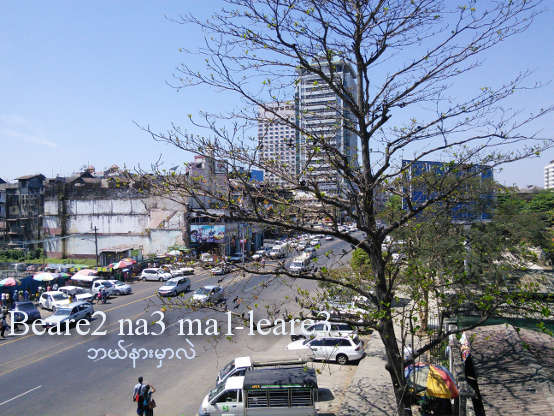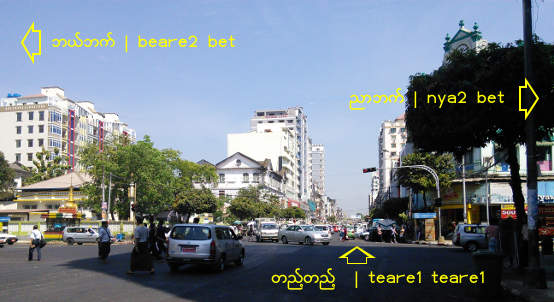Asking for Directions: A Tourist Story
In lesson 5, we have seen how our tourist got lost in the street of Yangon. His five-days Mission: to seek out new culture & strange civilizations, to attempt at speaking Burmese language, and to boldly go where no tourist has gone before.
Tourist:
ညီလေး | nyi2-lay3 — young brother
ဆာကူရာတာဝါ | Sakura Tower — Sakura Tower
ဘယ် | beare2 — where
နား | na3 — nearby
မ | ma1 — at
လဲ | leare3 — ?
ညီလေး ဆာကူရာတာဝါ ဘယ်နားမှာလဲ
nyi2-lay3, Sakura Tower beare2 na3 ma1-leare3
How do I get to Sakura Tower, young brother?
Note: It is common for Burmese people to address to strangers with family terms. မောင်လေး | moun2-lay3 is the equivalent of ညီလေး | nyi2-lay3 used by a female to a male younger than her.

နား | na3
from the word အနီးအနား | a-ni3 a-na3 meaning vicinity is used as a suffix word nearby.
We have seen the postpositional marker hma2 before. The word
မှာ | hma2
is a location indicator, which means in, at, on, etc.. If you speak slowly word by word, the above sentence might sound:
ဘယ်နားမှာလဲ | beare2 na3 hma2 leare3
But, with the normal flow of speech, it sounds more like:
ဘယ်နားမလဲ | beare2 na3 ma1-leare3
Nearby where?
That's a complete sentence that you can ask, for example, when someone mentions a place for you to go.
The Street Vendor:
ဒီကနေ တည့်တည့်သွား
de2 ga1 nay2 teare1-deare1 thwa3
Go straight from here.
လမ်းထောင့်မှာပဲ
lun3-doun1 hma2 beare3
It's at the corner of the road.
(Corner is spelled "htoun1" but read "doun1".)
Let's analyze this into detail:
ဒီကနေ | de2 ga1 nay2
from here (here + from + where you stay or stand)
တည့်တည့်သွား | teare1-deare1 thwa3
go straight (straight + go)
လမ်းထောင့် | lun3-doun1
at the corner of the road (road or street + corner)
မှာပဲ | hma2 beare3
located right there (at + exactly!)
ဒီကနေ တည့်တည့်သွား လမ်းထောင့်မှာပဲ
de2 ga1 nay2 teare1-deare1 thwa3
Go straight from here.
lun3-doun1 hma2 beare3
It's at the corner of the road.
Tourist:
လမ်း | lun3 — street; road
ထောင့် | doun1 — corner
မှာ | hma2 — at
ဟုတ်လား | hote la3 — Is that so? (yes + ?)
lun3 means road or a street, and doun1 refers to the corner. So, lun3-doun1 means street corner.
However, lun3-doun1 alone is not a complete sentence. You need to add at least postpositional marker hma2 to mean at the corner of the road. So, you can say:
lun3-doun1 hma2
when someone asks: "Where is it?"
လမ်းထောင့်မှာ ဟုတ်လား
lun3-doun1 hma2 hote la3
at the corner, you say?
Tourist continues:
ဘယ်ဘက်
beare2-bet — left side (left + direction)
မှာလား
hma2 la3 — Is it there? (at + ?)
ညာဘက်
nya2-bet — right side (right + direction)
မှာလား
hma2 la3 — Is it there? (at + ?)
ဘယ်ဘက်မှာလား ညာဘက်မှာလား
beare2-bet hma2 la3... nya2-bet hma2 la3
left side or right side?

It is possible to shorten the above sentence. You can ask the question:
nya2-bet hma2 la3
which means
"Is it on the right side?"
The Street Vendor:
ညာဘက်မှာ | nya2-bet hma2 — It's on the right side.
(right + direction + at)
Do you see the simplicity of sentence construction in Burmese? You don't need lengthy questions and answers to be understood. As we have seen in lesson 2, la3 is equivalent of the question mark.
The Street Vendor continues:
လမ်းကူး | lun3 ku3 — cross the road
(road + cross or swim)
ဖို့ | bo1 — for
(something necessary to do)
မလိုဘူး | ma1-lo2 bu3 — No need
(not + need + negative ending)
လမ်းကူးဖို့ မလိုဘူး | lun3 ku3 bo1 ma1-lo2 bu3
No need to cross the road.
ma1-lo2 bu3
means no need. For example, you can ask the question:
lun3 ku3 bo1 lo2 la3
"Need to cross the road?"
Unlike in English, nobody will ask: "Do I need to cross the road?" It's not necessary to include "I" in the above sentence. When it comes to "yes" or "no" answers in Burmese, simply use back the verb in the question.
ma1-lo2 bu3
means "no" and
lo2 deare2
means "yes" where lo2 is the verb "to need".
Tourist:
ဟုတ် ... ကျေးဇူး ပဲ
hote... kjay3-zu3 beare3 — Got it, Thanks..
(Yes + thanks + exactly!)
As we have seen in lesson 2, ကျေးဇူး | kjay3-zu3 is a help or merit that a person does on an another person.
Airline offices are located in Sakura Tower. The tourist needs to go to the Silk Air office to change his departure flight so that he can extend his five-day visit by a few more days. He has 28 days tourist visa, so it is not a problem as far as immigration is concerned. But now, he has to find Silk Air in Sakura Tower.
Tourist to Security Guard at the lobby:
SilkAir ရုံးခန်း | Silk Air yone3-gun3 — Silk Air office
(Silk Air + office + room)
ဘယ်ထပ် | beare2 htut — which floor?
(where + suffix for floor or level)
မှာလဲ | hma2 leare3 — at + ?
Silk Air ရုံးခန်း ဘယ်ထပ်မှာလဲ
Silk Air yone3-gun3 beare2 htut hma2 leare3
Which floor is Silk Air Office?
Note the sentence construction: "Silk Air office which floor at?" When you ask "what", "where", and "when" types of questions in Burmese, always place the subject of the conversation in front. "This is what?", "Washroom where?", "Meeting when?", etc.. Chinese speakers will find it easy because the pattern is similar.
Security Guard:
ဒုတိယ | du1-ti1-ya1 — second
ထပ် | htut — floor
မှာ | hma2 — at
ပါ | ba2 — polite ending word.
ဒုတိယထပ် မှာပါ | du1-ti1-ya1 htut hma2 ba2
(It's) on the second floor.
When it comes to floor levels in the buildings, Burmese don't use the simple 1,2,3 or tit...hnit...thone3 for the first 3 floors. Instead,
ပထမ | pa-hta1-ma1 (the first)
ဒုတိယ | du1-ti1-ya1 (the second)
တတိယ | tut-ti1-ya1 (the third)
are used. We will learn to say numbers in lesson 12.
Tourist:
ဒီကနေ | de2 ga1 nay2 — from here
(here + from + where you are at)
ဘယ်လို | beare2 lo2 — how
သွား | thwa3 — go
မလဲ | ma1-leare3 — shall + ?
ဒီကနေ ဘယ်လို သွားမလဲ | de2 ga1 nay2 beare2 lo2 thwa3 ma1-leare3
How do I go from here?
"Here + from + how + go?" Try to think of it this way. You are here. From that position, how to go?
Alternatively, you can add the word "ya1" meaning "to get" or "can be done" to mean "how can I get there from here?"
ဒီကနေ | de2 ga1 nay2 — from here
(here + from + where you are at)
ဘယ်လို | beare2 lo2 — how
သွား | thwa3 — go
ရ | ya1 — can be done
မလဲ | ma1-leare3 — shall + ?
ဒီကနေ ဘယ်လိုသွားရမလဲ | de2 ga1 nay2 beare2 lo2 thwa3 ya1 ma1-leare3
How can I get there from here?
Security Guard:
ဓါတ်လှေကား | dut-hlay2-ga3 — elevator (electric + stairs)
စီး | si3 — ride
လို့ | lo1 — to take that course of action
ရတယ် | ya1 deare2 — can be done.
Now, try to think like a Burmese. Think of the object or subject in your head first. In this case, it is the elevator. What are you going to do with it? You are going to ride in it. It is a possibility and can be done. "Elevator ride can be done."
ဓါတ်လှေကား စီးလို့ ရတယ် | dut-hlay2-ga3 si3 lo1 ya1 deare2
You can take the elevator.
Everything goes fine with the air ticket, but as the tourist comes out of the building, an emergency situation arises all of a sudden. It must be the combined effects of mone1-hin3-ga3 (fish gravy rice noodle) in the morning and spicy chicken Biryani that he had earlier.
The tourist is searching for words in his head to make an emergency request. He remembers
အိမ်သာ | ain2-dtha2
is the Burmese word for toilet.
သွားချင်တယ် | thwa3 chin2 deare2
means "I want to go". So, he can construct the sentence like this:
အိမ်သာသွားချင်တယ် | ain2-dtha2 thwa3 chin2 deare2
"I want to go to the toilet."
But, wait... Save this sentence for some other time. What he really needs to do now is to ask whether there is a toilet around here.
Tourist:
ဦးလေး | u3-lay3 — Uncle
ဒီနားမှာ | de2 na3 hma2 — around here
(here + nearby + at)
အိမ်သာ | ain2-dtha2 — toilet
ရှိလား | shi1 la3 — present + ?
ဦးလေး၊ ဒီနားမှာ အိမ်သာ ရှိလား
u3-lay3.. de2 na3 hma2 ain2-dtha2 shi1 la3
Uncle, is there a toilet around here?
Why not place "toilet" in front of "around here"? Isn't the object or subject supposed to come first in the sentence? Yes, it can be done, but it doesn't sound so good. Maybe because it is not the question of "where" the object is, but the question is "whether" the object exists with the emphasis on "around here". At the airport or in the restaurant, you can ask where the washrooms are, but it does not sound very natural to ask "toilet where?" in the middle of the street.
The elder gentleman :
လမ်း | lun3 — road
ဟိုဘက် | ho2-bet — the other side
(there or that + direction or side)
မှာ | hma2 — at
ရှိတယ် | shi1 deare2 — present + affirmative.
Try to picture the "road" in you head first. On the other side "is" the answer to the question.
လမ်း ဟိုဘက်မှာ ရှိတယ် | lun3 ho2 bet hma2 shi1 deare2
There's one on the other side of the road.
တံတား | da1-da3 — bridge
ပေါ် | pau2 — on top or over
က နေ | ga1 nay2 — from
(from + where you are at)
သွားပါ | thwa3 ba2 — go + suggestion.
တံတားပေါ်ကနေ သွားပါ | da1-da3 pau2 ga1 nay2 thwa3 ba2
cross the road from the bridge.
Tourist:
ကျေးဇူးပဲ ဦးလေး | kjay3-zu3 beare3 u3-lay3 — Thanks, Uncle..
(thanks + exactly + Uncle)
And, not long afterwards, the tourist sees his destination from across the road. He smiles with relief as he walks into the sunset over the bridge.
The End.
